16 min read 🤓
A Block with a Name
(aan de Rand van Nederland)
april 01, 2009.
I noticed that I had forgotten to bring my toothbrush when on friday march 20th I arrived at my mother's. That is in Malberg, a 1960s suburb of the city of Maastricht. My mother still lives there in the small one story house that I grew up in, at a mere meters distance from the Belgian border.
So I walked down to the shopping center, to buy me a toothbrush.
These shopping centers - think of them as mini-malls (pun
intended :-) ...) - were conceived as the hearts of the suburbs
that in the second half of the last century spread like fungi all around
the old town. All of them are alike. You will find them as part of a pretty
much empty square in what is more or less the geographical middle of the
suburb. The bulk of the space there is reserved for parking, though most
of the time most of that space will not be taken. And then there are two
bus stops: one for busses that take you a couple of stops further into the
suburb, and one for busses that'll take you out of there. The square will
be surrounded by a number of rectangular blocks of three to four stories
high apartment buildings, whose ground floors are occupied by the shops
that together make up the mini-mall. Generally it will include
a supermarket, a butcher, a bakery, a drug store, a stationer's shop/bookstall/post
office, and a bank. Sometimes you will find there's also a flower shop,
a fish store, a chinese restaurant, a café or a snack bar; but often also
you won't.
There is not a single shop elsewhere in the suburb.
There's just these and these are there.
Some 40+ years after its initial construction the city council of Maastricht felt that the suburb of Malberg was in dear need of a makeover. That is why the block buildings around the shopping center square (the Malbergplein) one by one are being torn down. And then replaced by new blocks that, at least from the outside and for a casual visitor like myself, only look slightly other than the old ones ...
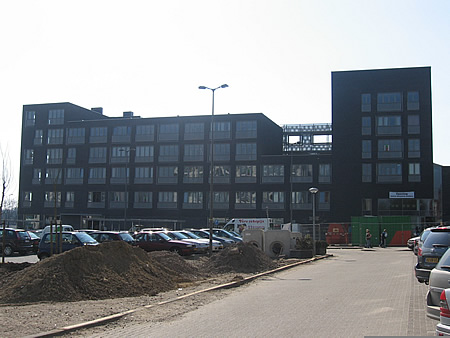 |
The first of these new blocks recently got delivered. But it's no longer just a block. It became, in urban planners' Dutch, a Multi Functionele Accomodatie, a Multi Functional Accommodation (MFA); bref, it's a block with a mission, accommodating in one building not only shops and apartments for living, but also a community house, the Malberg primary schools and Trajekt, an enterprise dealing in welfare (work). It even was given a name: Centre Manjefiek Malberg.
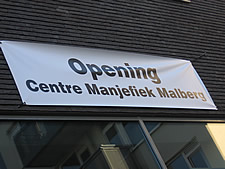 When
I arrived there friday to buy a cheap toothbrush at the Jumbo
supermarket there was a white banner attached to the facade, proudly
announcing the Centre's opening.
When
I arrived there friday to buy a cheap toothbrush at the Jumbo
supermarket there was a white banner attached to the facade, proudly
announcing the Centre's opening.
A DJ had set up a set of booming
speakers and a mixing desk, and played dutch schlagers for a handful
of sympathizers that were tapping their feet and swaying their heads.
Maybe also a bit to keep warm, for notwithstanding spring's immanent arrival,
it was rather cold, and all were standing in the shadow, as the block blocked
out the sun. There were also two baskets full of pigeons.
Something was bound to happen there, so I joined the ranks of those
that were there waiting ...
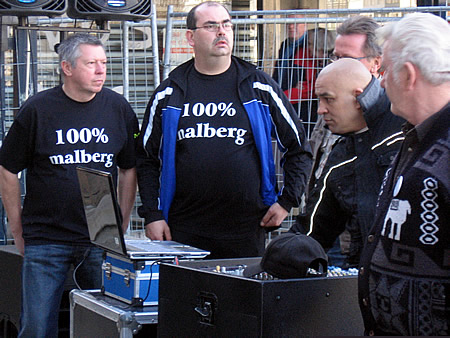 |
And something did happen. A man took the microphone, and began telling us how proud he was that after some two years of hard work there we were, tenants, planners, entrepreneurs and employees, all together, in front of this magnificent new construct that had arisen in the center of a magnificent suburb. While he did I saw several onlookers that waveringly surveyed the pretty banal and very straight gray walls of the new building. Somehow they seemed not convinced ... But just how magnificent the Centre Manjefiek Malberg had become was difficult to tell from the outside, the man hurried to assure us. So he invited all to come inside and have a look around. First, though, he released the pigeons from their baskets ...
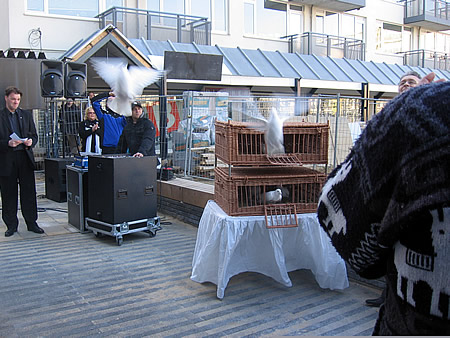 |
No sooner had the birds flown, or the DJ hurriedly began wrapping up his gear, while those that had stood watching and applauding the flying doves lined up to pass through the door and have a look inside the Centre. Again curiosity got the best of me, and I followed them inside ...
There were no "Ohh!"'s, and there were no "Ahh!"'s ...
People were driven into some sort of an events and party run, past a couple of friendly ladies that handed each one or two coupons for drinks. I decided to have my curiosity stop right there, just before I'd pass the friendly ladies. And so it did. Almost. For my attention was drawn by an interesting construct, set against a wall in the midst of the hall of the MF Centre where there was a polished metal plate with a screen, and below the screen a solid metal wheel. There were also two steps, that one could go up, to turn the wheel and have a closer look at the screen. Along the front of the first of the two steps the word "tijdverkijker" was written, in large black capitals.
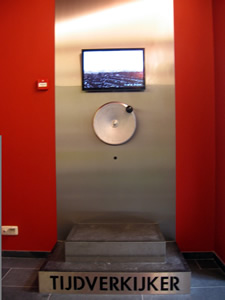 |
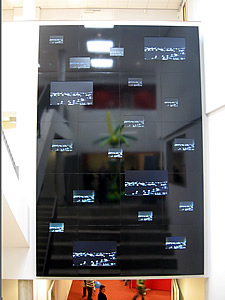 |
On the screen one looks out over the suburb of Malberg. Turning the wheel, the view changes: it is a panoramic view, one may
look around in any direction. But not only does turning the wheel change the spatial angle of one's outlook,
when I continued to turn, to my surprise it also modified 'my' position in time, giving one the rather dazzling impression of moving
along a spiral space-time staircase that somehow has been opened up at that particular spot. While spinning the wheel around and around I
saw day change into night into day, while rain became sunshine and sun became rain ...
The image on the screen is repeated on a number of differently sized screens embedded into
a shiny black (plastic?) surface, suspended in the building's central staircase (see the picture).
De Dutch neologism 'Tijdverkijker' is a very appropriate name for this little monument. 'Verkijker' is like 'verrekijker', which is Dutch for binoculars. It is a noun derived from the verb verkijken, the meaning of which partially corresponds to that of the english verb misjudge: to see (or less literally: interpret) something in a wrong way, or as something else. It also may be interpreted as: ver kijken, meaning 'to look far (ahead)'.
The 'Tijdverkijker' obviously is a work of art, chosen for this public space, and quite evidently both part and expression of the Maastricht urban developers ambitions for this MF Centre Manjefiek Malberg. I think that for once they made an interesting choice. I found it curious though to see that there was no mention at all of the artist's name. I asked a number of people that looked like they might know, but none of them did ...
A little later, walking back to my mother's house with my new toothbrush, I saw the camera, turning round and round in jerky leaps, high up on the roof of the Manjefiek Centre, overlooking the suburb ... A silent and tireless mechanical watcher, and one that never sleeps. There is actually something slightly threatening about the way it is stuck there, out of reach, an all-seeing Big Brother's eye high up on a pole on the roof ... (I could imagine that some day someone might find this something one should have a shot at; it is indeed here, on the outside, that one realizes that below the instructive and playful presentation inside of the "Tijdverkijker" as a game with space and time, there lurks this layer of persistent surveillance ...)
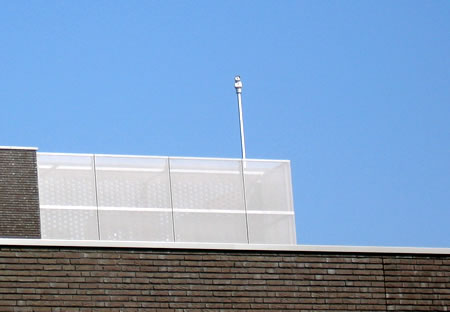 |
That evening I walked over to Kaspar König's ArtSpace Rondeel. Things looked very different there since my last visit, with ookoi and Radio Raudio during last year's Kunsttour ... Kaspar got hold of an old red hot air balloon, and with the help of a warm air blower, he and his friends inflated the little monster inside the ArtSpace. The result is stunning, as the inside of the balloon makes for a gorgeous space inside the Space.
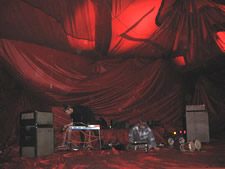 |
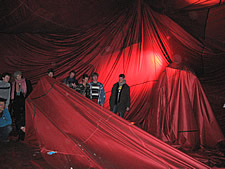 |
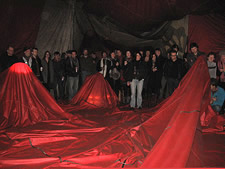 |
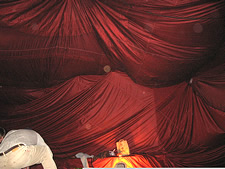 |
The balloon provides this former home to an asbestos removal company with a, a second, an interior skin, and there was a trio of dancers that crept under it. They had it bumping and stumping with random growths and folds (see the pictures) in between the two noisy duets that were performed there that friday evening ... Edd Noi$ & Willy Fistw€ll (again names that were well chosen indeed) were responsible for the first of these nois-erts. Edd had a contact mike to scrape the floor with, and a couple of bongo's. Once or twice during their performance Edd squeezed the little drums between his legs, and - let me say this in Dutch - gaf dan een staaltje roffelen weg waarvoor hij op de muziekschool in de trommelklas ongetwijfeld een gouwe medalje met kneepje van de juffrouw zou hebben gekregen. He also had a cymbal. That he smashed onto the floor. It sounded like 'bengg!'. He did it again. And one more time to mark the end of the performance: hopla, and 'bengg!'. Unfortunately Willy did not grasp Edd's intention: he just noised on. So Ed picked up the cymbal from the floor. He gave Willy the eye ... and smashed the cymbal onto the floor a second time ... Dit keer was Willy bij de les ...
In the Asbest Bar I bumped into Jodi Rose, who's staying at the ArtSpace. She was having a great time, and says hello to you all ... She just loves Maastricht, and will probably be doing a bridge there during the upcoming Kunsttour, may 21st-25th.
Time flies when you're having fun, and it was pretty late already when
Kim Laugs and Rinus van Alebeek turned up the amplifiers.
They were big amplifiers, that came with big
speakers. Rinus had spread out his cassettes over the floor, with his dictaphones
and effect goodies in between. Kim nestled himself in the midst of it all,
staring at his Mac laptop's screen while Rinus busied about, adjusting things
here, then re-adjusting them again; putting stuff there, and then re-putting
them elsewhere. Had we been outside and would there have been the light
of day, I could have sworn the two were preparing for a neighborhood garage
sale - at which indeed I would have been eager to buy. But in the crepuscular
red shimmering reflection of the balloon's creases, the market place became
the lieu for a shamanic ritual, with, say, Rinus as the shaman,
and Kim as the hi-tech sorcerer's apprentice.
But hey! Was I not ready for that as well ... ?
Actually I was pretty much convinced they'd be able to do it: have the ArtSpace's
roof go off, then gently lift the red balloon with them and all of us inside;
have it float away into the Maastricht night sky ... I watched Kim being
busy with his laptop's keyboard. Surely by now he was entering meteorological
and geographical data, crucial so as to avoid crashing into the Sint Jan's
or some other of the many Maastricht churches' towers. And Rinus, with a
serious and determined look, indicating that such things were not
to be taken lightly, continued to fine-tune the amplifiers' controls, so
as to assure that take off would be smooth, and the subsequent trip a truly
up-lifting experience ... For of course, as you'll have understood,
this balloon was about to be driven by sound.
Oh yes, I was ready for it!
 |
Unfortunately, though, none of all this was to be ...
Should Rinus have avoided to put a paper bag reading 'BOM' so prominently
up as a prop? It is hard to tell. Fact though is that no sooner Kim and
Rinus set their 'thing' into motion, one quickly forgot about red balloons
and starry European spring skies. Within less than - maybe - a couple of
minutes they had conjured up an old rusty and sadly top-heavy metal-ic learjet,
of which already a moment later they lost control again, high up in a clear
and cloudless sky. That, on top of it all, deprived them from the unforeseeable - hence
possibly interesting - play of random turbulence ... They soon also lost
pretty much all of their passengers, who could not care less where the two of them
were heading. They covered up their ears and walked out for a drink at the
bar, while the doomed machine raged on ... It left Kim and Rinus with an
empty plane, rumbling on out of control somewhere high over one of this
or some other world's near to endless oceans, where it even no longer
had the power to destroy ...
I found it interesting to experience just how impotent such 'noise'
(or was it merely 'loud sound'?) could turn out to be, despite its aggressive
loudness and notwithstanding its being produced with the intention to surprise
and captivate an audience. It also - maybe superfluously, but nevertheless
- once again conclusively demonstrated that the days that generating a 'modulating
block of dense-frequency sounds' (which is the other side of silence, the
yang of sound's yin; it can be effectuated in a zillion
different ways, the experiential results of which will differ only in minor
details) might at least be considered a statement of sorts, and about
something, are long gone.
With but very few exceptions this sort of 'nois-ert' in general indeed often manages to express little more than maybe some dose of ado-macho pathos ...
As I noticed time and again, most audiences that are exposed to such 'noise improvisations' - with the understandable but nevertheless notable exception of those that are themselves 'practitioners' - rather than being annoyed, shocked, intrigued or aroused, mostly are very quickly utterly bored by them; who has seen one, has seen them all. Or, let's be fair: has seen most of them. For there are of course the (exceptional) occasions that the result does make for a worthwhile experience, musical or otherwise. But for the bulk it holds that the longer they last, the more impotent they get. When the average nois-ert stops, there is nothing that remains ... Even the too readily acclaimed bodily experience provided by 'noisy impro', which is supposed to be caused by the noise's loudness (with guts shaking basses and ear piercingly un-pleasant high frequencies), in view of the in most cases completely inapt technical means that 'underground'/fringe artists have at their disposal to bring this about, is peanuts when compared to the 'loud sound feel' that most of those present surely will have experienced many times before, at your average bourgeois saturday night dance event or during a 'banal' rock band concert ...
So what's the point?
Audiences will mostly and rightly feel weary in view of an umpteenth attempt
to (un-)shock them, or have them witness the (re-)invention of a wheel.
Unless the performers manage - in some way or other - to establish from
the start the ('sado-masochistic') contract with the viewer that will oblige
her to stay and follow on.
When there are no others to engage, what results is at the very most an
autocatharsis, sort of like masturbation ... Ah well, I guess at
times all of us will be into that,
no?
Maybe that's a consolation.
I was reminded of all of this again when just days later I chanced upon a concert by a flemish four-piece called Phlitman & Kangaroo. That was on thursday evening, march 26th, in the Brussels café De Walvis. The band played a set of post-punk inspired energetic rock, entertaining and agreeably unpretentious. But also quite interesting, not in the least because of its many im- and explicit 'musico-historical' references. The band ended its set that evening with a longish piece of noise-rock that started out as something by the Velvet Underground (with a Cale-ish violin) and then gradually gave way to a power-noise drive reminiscent maybe of Sonic Youth. Despite the completely different instrumentation, I realized somewhere in the middle of it, that this Phlitman & Kangaroo piece that I was listening to in De Walvis sound-wise did not differ very much from the mattress of sound that Kim and Rinus produced in the ArtSpace; apart from the fact that the Kangaroo had 'established the cont(r)act', stayed in control all the way, and thus managed to captivate and carry me along, together with a significant part of the audience.
Be that as it may. Flying or crashing or just staying put: I had a good time inside the ArtSpace Rondeel balloon. It was very late when I left the place, and walked back to my mother's ... So let me show you - for no particular reason at all - a picture of a house on the Cabergerweg that I took that night on my way back from the Rondeel.
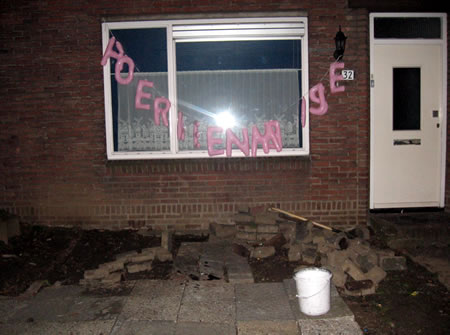 |
Next afternoon I passed the Centre Manjefiek Malberg again, and I decided to have another look at the Tijdverkijker. Good thing that I did, as it turned out that about that time there was the work's official unveiling, right after een onwijze set in the courtyard by the Dutch girlie pop dance trio Djumbo, with streetdancers and majorettes ... I actually more or less bumped into the artist, whose name, I learned, is Geert Mul. I could not stay long enough to attend the actual unveiling, but there was time for a little chat, during which, most notably, Geert showed me the back side of the Tijdverkijker. It's a cupboard, in which there is the computer on which the stream of images made by the camera are being stocked. The 4Tb of storage that it comes with, Geert told me, should be enough to keep a full year of sequential 'surround' images, whence eventually it will be possible to travel up and down along a time/space spiral spanning the four seasons ... A glance inside shows the brilliantly simple mechanism that the work uses to track the movements made by the visitors that are spinning the Tijdverkijker's wheel, and lead these on to the image-displaying software. I will let you try and work out the principle for yourself ... Here's a photograph of the inside of the cupboard.
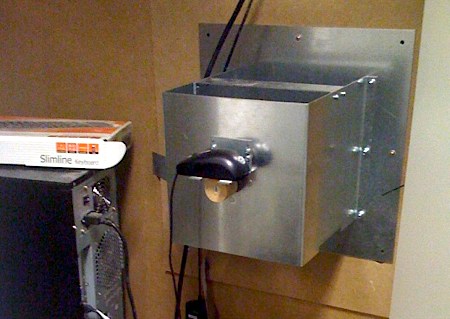 |
The Tijdverkijker is an ingenious and enjoyable work, that I am happy to have discovered. On the
other hand, other than, say, a stone or metal sculpture, this is not the
most robust type of art work to display in public space. Do you
remember Marinus
Boezem's Visual Sound Project, on the corner of the Willemstraat bridge and the Academiesingel
in Breda, that by chance we - literally - stumbled upon with Diktat sometime in the fall of 2007?
I'm curious indeed
to see how the Tijdverkijker itself will stand the passage of time, that is one of its principal
subjects ...
Let me keep an eye on it.
An outsider's eye ...
[ Geert Mul's Tijdverkijker was produced by Joost ten Bruggencate
for art enterprise Mothership;
software programming: Carlo Prelz.
added sept. 8th, 2009 : Geert Mul's Tijdverkijker
uTube explains and demonstrates the functioning of the installation. ]
tags: Maastricht, ArtSpace Rondeel, Geert Mul, Malberg, time, noise, noise music
# .300.
Read more about Artspace Rondeel Maastricht (ARM) on the SoundBlog:
(june 28, 2011) - the end of an arm, the end of an era
(may 30, 2010) - Auto*noom
en un*titled
(february 24, 2010) - "Zonder
Vreesch, want immer Dapper, gaan wij des Zondags naar den Kapper..."
(november 11, 2009) - Waiting
in the Wings, often
(july 09, 2009)- Cover
thyself
(june 01, 2009) - Playing
The Popular Classics
(april 01, 2009) - A
Block with a Name
(june 06, 2008) - Raudio
Graffiti: almost live !
comments for A Block with a Name ::
|
Comments are disabled |